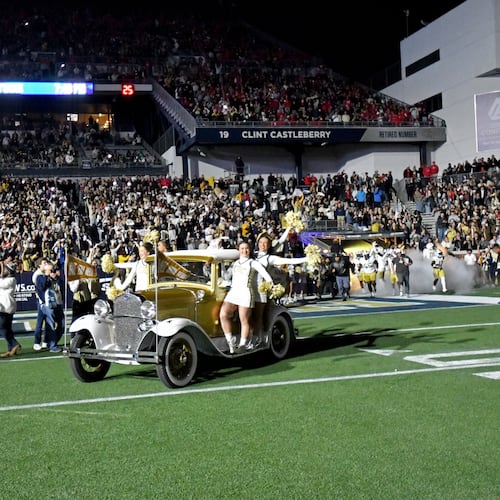Through 10 games, Georgia Tech has not shot the 3-pointer as well as coach Josh Pastner expected his team would before the start of the season.
Pastner said he based his expectation on “the way we were shooting in practice, our shooting drills, the way we shot against Vanderbilt and Tulane (in practice games), shot pretty well against Clayton State (in the season opener).”
As of Friday, Tech was making 30.3% of its 3-point tries, placing the Yellow Jackets at 310th in Division I, second to last in the ACC. Pastner’s least accurate team in his tenure, now in its seventh season, made 30.7% of its 3-point attempts. The Jackets play their 11th game of the season Saturday at home against Alabama State. After that game, the Jackets will dive into ACC play, starting with Clemson at home Wednesday.
Scoring from the perimeter is more critical for this team than past teams, as the Jackets haven’t been consistently effective at scoring inside the 3-point arc, making steady contributions from beyond it more important.
It weighs heavily, too, because there aren’t a lot of things that the Jackets do well to give themselves chances to win games. Tech has been exceptional at avoiding turnovers and, as usual, defending the 3-pointer. But with limited size, Tech has given up piles of extra possessions with poor defensive rebounding. Post players Rodney Howard and Ja’von Franklin have shown signs of becoming dependable scorers, but aren’t adept at making plays for teammates out of the high post in the team’s Princeton offense. The Jackets don’t get to the free-throw line with great frequency.
(Tech has other challenges for its game against Alabama State. Franklin is doubtful with a groin injury, and guards Deivon Smith and Deebo Coleman are questionable with ankle and Achilles injuries, respectively.)
Three-point shooting, particularly with adept shooters Miles Kelly and Coleman in the lineup, is one area where Tech could help itself out with better play.
“It’s humongous,” Pastner said. “It’s of tremendous importance to us. Now, we don’t have to live and die by it, but we don’t have a lot of margin for error.”
Kelly and Coleman are hitting their marks. Together, they average 37% (37-for-100). The rest of the team is 23.2% (22-for-95). Guard Lance Terry, who made 35.0% of his 3-point tries last season at Gardner-Webb, has made 31.3% (10-for-32). Smith has made 14.3% (2-for-14) after making 27.8% last season (5-for-18).
The Jackets shot 34.6% (9-for-26) at North Carolina on Saturday, their second-highest rate of the season against Division I competition. Coleman was confident in a continued uptick.
“I would just say now that we’re not in the beginning of the season. We’ve got a flow, and we’ve got a rhythm going. We’re just more comfortable and playing a little bit looser out there, not playing as tight,” he said.
How likely is it that the Jackets could meaningfully break the pattern set in their first 10 games, especially going against presumably more challenging defenses in ACC play?
It depends a little bit on what the definition of meaningful is.
Of the 15 ACC teams going into games Dec. 21 last season (the day of Tech’s 11th game), five improved their 3-point percentage by more than one percentage point, five stayed within one point and five dropped more than one point.
The good news for Tech is that four of the teams that moved up by a point or more were shooting 32.8% or worse, as the Jackets are.
Pastner might try to figure out what N.C. State did, which went from being a 30.5% shooting team to finishing at 34.1%, making 35.9% of its shots over its final 21 games.
Moreover, of the 12 power-conference teams that were shooting between 30.8% and 29.8% on Dec. 20, 2021 (the teams closest to the 30.3% that Tech is shooting now), all 12 saw their shooting percentage improve, nine by 1% or more.
But, for Tech’s chances to be competitive in a season when it was picked to finish last in the ACC, the Jackets most likely need to improve by more than a single percentage point and probably by more than two.
For Tech to improve from 30.3% to 32.3% by season’s end, assuming that shots per game stayed consistent, the Jackets would have to shoot 33.4%. It’s better, but not exceptional and maybe still not what Pastner anticipated.
Of the aforementioned 12 teams, three improved by three percentage points or more. It’s conceivable, but not likely.
“We’ve gotten great looks,” Pastner said. “I believe we’re going to make them. We’ve just got to continue to get good looks. We’re due to get on a streak and get hot.”
About the Author
Keep Reading
The Latest
Featured


